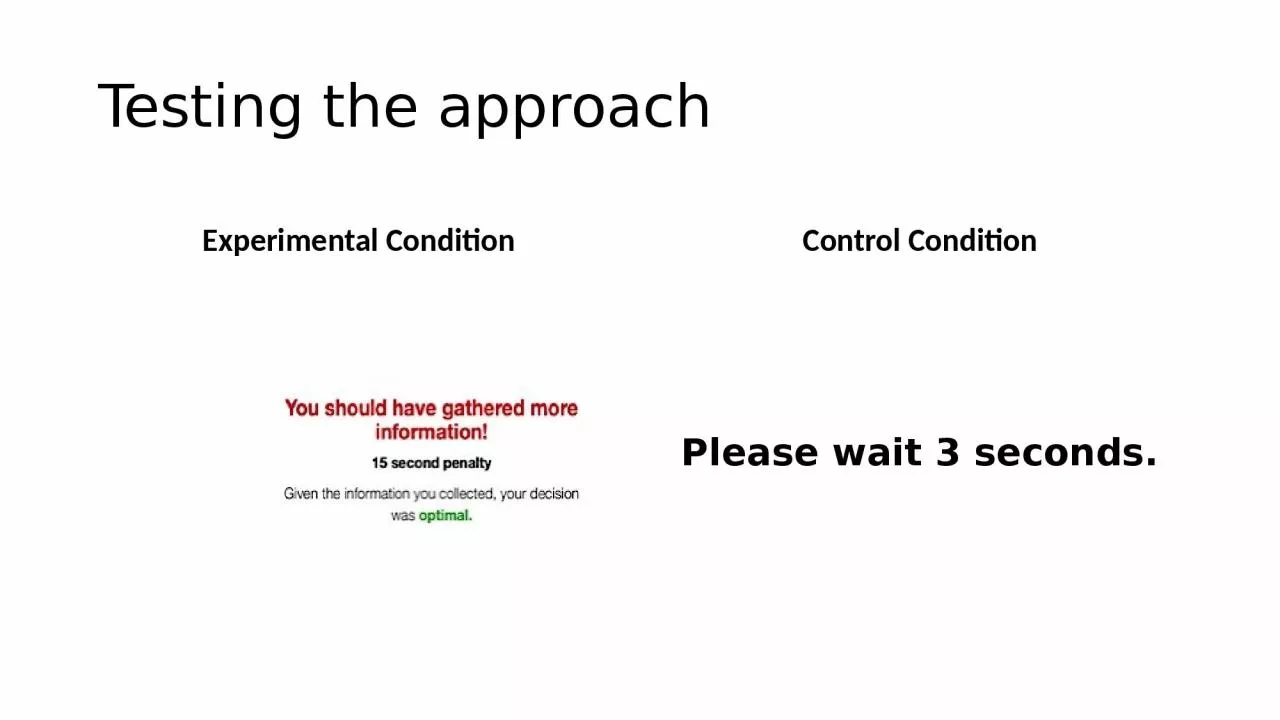

Control Condition Please wait 3 seconds Feedback promotes more planning Lieder KruegerCallaway amp Griffiths 2017 leading to higher performance Lieder KruegerCallaway amp Griffiths 2017 ID: 1027273
Download Presentation The PPT/PDF document "Testing the approach Experimental Condit..." is the property of its rightful owner. Permission is granted to download and print the materials on this web site for personal, non-commercial use only, and to display it on your personal computer provided you do not modify the materials and that you retain all copyright notices contained in the materials. By downloading content from our website, you accept the terms of this agreement.
1. Testing the approachExperimental ConditionControl ConditionPlease wait 3 seconds.
2. Feedback promotes more planning(Lieder*, Krueger*Callaway*, & Griffiths, 2017)
3. … leading to higher performance(Lieder*, Krueger*Callaway*, & Griffiths, 2017)
4. ConclusionsResource rationality provides a framework that is realistic yet still systematic as a source of modelsMany standard heuristics are not just “kluges” but are resource-rational for some architectureThis approach lets us tackle questions about how people use their cognitive resources, and how to design systems to overcome those limitations
5.
6. Availability of extreme eventsAvailability bias: people over-estimate the probability of events that come to mind easily(Tversky & Kahneman, 1973)Extreme events come to mind easily…
7. Availability of extreme eventsTask: Estimate the expected utility of an actionArchitecture: Generate (weighted) samples of possible outcomes of the actionCost: Increases linearly in the number of samples (as with opportunity cost)(Lieder, Hsu, & Griffiths, 2014)
8. Unbiased sampling is bad…
9. Importance samplingp(x)q(x)
10. The optimal distributionVariance is minimized by…But, the result is biased: with small samples, we will over-represent extreme events(Lieder, Hsu, & Griffiths, 2014)
11. Over-representing extreme eventsρ = 0.53(Lieder, Hsu, & Griffiths, 2014)
12. A simple optimal heuristicWhen making a decision…generate from the utility-weighted distributiontally the number of pros and consReproduces phenomena in decision-makingfourfold pattern of risk preferences (Tversky & Kahneman, 1992)Allais paradox (Allais, 1953)outperforms cumulative prospect theory in the Technion dataset (Erev et al., 2010)
13. Fourfold pattern of risk preferencesOverweight gain/loss of risky gamble if p small(since |u(o)-u(p.o)| is greater than |u(p.o)|)Underweight gain/loss of risky gamble if p large
14. Allais paradoxL1: 66% chance of $2400, 33% chance of $2500, 1% chance of $0L2: 100% chance of $2400 L1: 33% chance of $2500, 67% chance of $0L2: 34% chance of $2400, 66% chance of $0
15. Allais paradox
16. Technion resultsr = 0.88
17. Anchoring and adjustmentWhat’s the freezing point of vodka?How long is Mars’ orbit around the sun? People answer these questions by starting with a more familiar example (an anchor) and adjusting away from it (leading to bias)(Epley & Gilovich, 2006)
18. Anchoring and adjustmentTask: Estimate a quantity based on memory and other cuesArchitecture: Markov chain Monte Carlo via the Metropolis-Hastings algorithmCost: Increases linearly in the number of samples (as with opportunity cost)(Lieder, Griffiths, & Goodman, 2012)
19. Metropolis-Hastings
20. Bias is resource-rational(Lieder, Griffiths, & Goodman, 2012)
21. Anchoring and adjustment(data from Epley & Gilovich, 2006)(Lieder, Griffiths, & Goodman, 2012)
22. Other predictionsCognitive load, time pressure, and alcohol reduce adjustment (Epley & Gilovich, 2006)Bias increases with anchor extremity (Russo & Schoemaker, 1989)Uncertainty increases anchoring (Jacowitz & Kahneman, 1995)Knowledge can abolish the anchoring bias (Wilson et al., 1996)
23. Effects of time and error cost
24. Waiting for the bus
25. Experiment results
26.
27.
28. Investment taskTwo strategies: Take The Best (TTB) vs. weighted combinationTwo environments: noncompensatory vs. compensatory(Lieder & Griffiths, submitted)
29. Model predictions (data from Reiskamp & Otto, 2006)
30. Flexible strategy use(Lieder & Griffiths, submitted)
31.